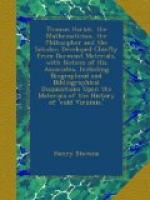On the back of the above title-page is another attempt of the same sort as follows, showing that this deed of pedantry was committed at Sion College:
CORRECTOR
sive
Notæ in Analyticam
Novam, Novatam, Posthuma
quatenus
Fallacem, Defectivam, Extrariam
cum
Apodictica refutatione Atomorum
Somnij, præ cæteris Novatorum
portentis corripiendi Ana-
thematizandiq
Ex Collegio Sion Londinenfi
perfuncti Senis Artemq reponentis
NT
Extremu hoc munus morientis
habetor :
Σĸηρον προς
κ
41;ντρονλ
α
κτρον λακτ
43;ζειν
[Greek Text]
nee bene Ripæ
Creditur ipse Aries etia nunc Vellera
ficcat.
There are one or two unimportant papers among the Torperley manuscripts that bear marks of having belonged to the Hariot papers, and there is a manuscript by Warner, entitled, ’Certayne Definitions of the Planisphere.’ Any one curious in the history of Torperley may find in the Calendar of State Papers, Domestic Series, 1636, page 364, how his property was purloined by Mr Spencer, the first Librarian of Sion College. He was sued by Mistress Payne the administratrix and was compelled to disgorge £4.0 in money, eleven diamond rings, eight gold rings, two bracelets, etc. Then Archbishop Laud took away Spencer’s librarianship, and let him drop.
Mr William Spence of Greenock published in Nov. 1814, a work entitled, ’ Outlines of a Theory of Algebraical Equations deduced from the Principles of Harriott, and extended to the Fluxional or differential Calculus. By William Spence. London, for the Author, by Davis and Dickson, 1814, 8°, iv and 80 pages. Privately printed, intended ’ exclusively for the perusal of those gentlemen to whom it is addressed.’ He says in his prefatory note that-
’ As the principles are drawn from that theory of equations, by which Harriott has so far advanced the science of algebra.’ The author says, page I,’ Until the publication of Harriot’s Artis Analytica Praxis, no extended theory of equations was given. Harriot considered algebraical equations merely as analytical expressions, detached wholly from the operations by which they might be individually produced ; and, carrying all the terms over to one side, he assumed the hypothesis, that, as in that state the equation was equal to nothing, it could always be reduced to as many simple factors as there were units in the index of its highest power.’
Between 1606 and 1609 a very interesting and historically instructive correspondence took place between Kepler and Hariot upon several important scientific subjects. Five of the letters are given in full in ‘Joannis Keppleri Alio-rumque Epistolæ Mutuæ. [Frankfort] 1718,’ folio, to which the reader is referred, but a brief abstract of them may not be out of place here. The letters are numbered from 222 to 226 and fill pages 373 to 382. The correspondence was begun by Kepler:




